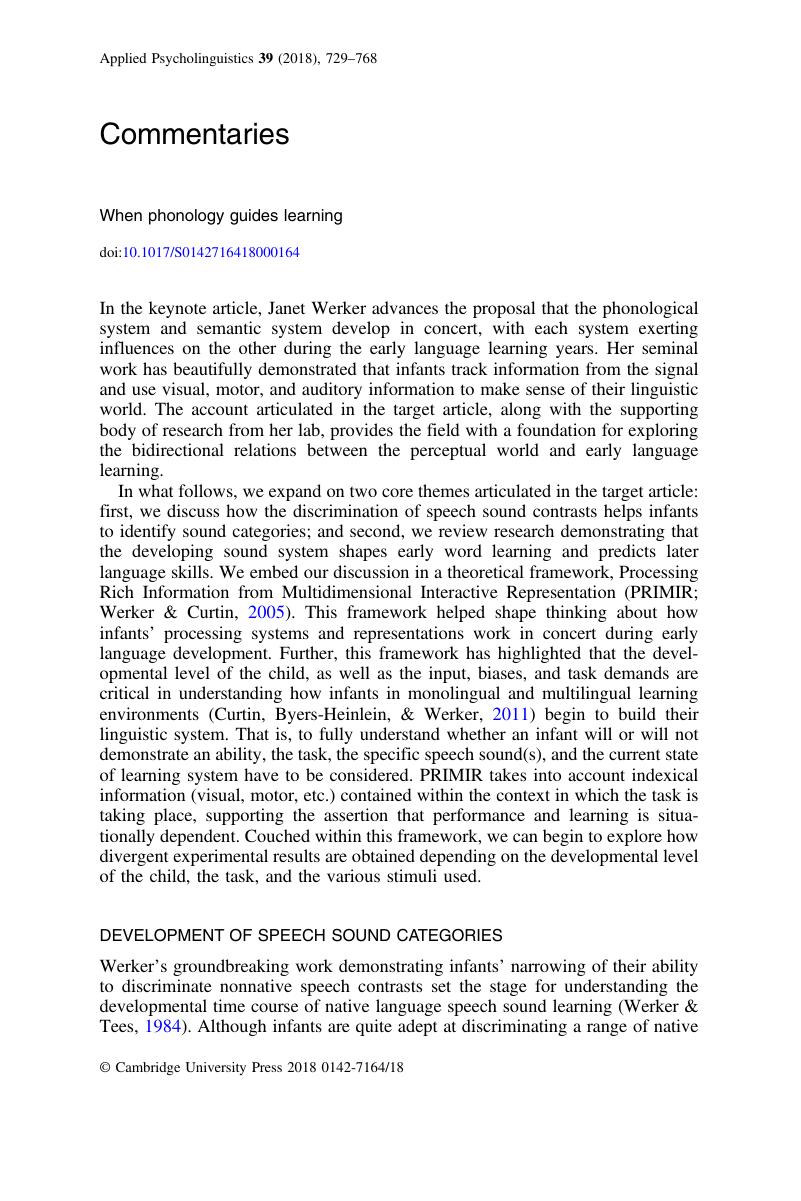No CrossRef data available.
Article contents
When phonology guides learning
Published online by Cambridge University Press: 11 September 2018
Abstract
An abstract is not available for this content so a preview has been provided. Please use the Get access link above for information on how to access this content.

Information
- Type
- Commentaries
- Information
- Copyright
- © Cambridge University Press 2018
References
REFERENCES
Archer, S., Ference, J., & Curtin, S. (2014). Now you hear it. 14-month-olds succeed at learning minimal pairs in stressed syllables. Journal of Cognition and Development, 15, 110–122. doi: 10.1080/15248372.2012.728544.Google Scholar
Archer, S., Zamuner, T., Engel, K., Fais, L., & Curtin, S. (2016). 12- and 20-month-olds’ ability to perceive coda consonants: Effects of position and voicing. Language Learning and Development, 12, 60–78. doi: 10.1080/15475441.2014.979490.Google Scholar
Bernhardt, B. M., Kemp, N., & Werker, J. F. (2007). Early word-object associations and later language development. First Language, 27, 315–328.Google Scholar
Curtin, S. (2009). Twelve-month-olds learn word-object associations differing only in stress patterns. Journal of Child Language, 36, 1157–1165.Google Scholar
Curtin, S., Byers-Heinlein, K., & Werker, J. F. (2011). Bilingual beginnings as a lens for theory development. Journal of Phonetics, 39, 492–504.Google Scholar
Curtin, S., Fennell, C., & Escudero, P. (2009). Weighting of acoustic cues explains patterns of word-object associative learning. Developmental Science, 12, 725–731.Google Scholar
Ference, J., & Curtin, S. (2013). Attention to lexical ltress and early vocabulary growth in 5-month-olds at risk for autism. Journal of Experimental Child Psychology, 16, 891–903.Google Scholar
Ference, J., & Curtin, S. (2015). The ability to map differentially stressed labels to objects predicts language development at 24 months in 12-month-olds at high-risk for autism. Infancy, 20, 242–262.Google Scholar
Graf Estes, K., Edwards, J., & Saffran, J. R. (2011). Phonotactic constraints on infant word learning. Infancy, 16, 180–197.Google Scholar
Graham, S. A., & Kilbreath, C. S. (2007). It’s a sign of the kind: Gestures and words guide infants’ inductive inferences. Developmental Psychology, 43, 1111.Google Scholar
Henderson, A. M., Graham, S. A., & Schell, V. (2015). 24-month-olds’ selective learning is not an all-or-none phenomenon. PLOS ONE, 10, e0131215.Google Scholar
Kemp, N., Scott, J., Bernhardt, B. M., Johnson, C. E., Siegel, L. S., & Werker, J. F. (2017). Minimal pair word learning and vocabulary size: Links with later language skills. Applied Psycholinguistics, 38, 289–314.Google Scholar
MacKenzie, H., Curtin, S., & Graham, S. A. (2012a). 12‐month‐olds’ phonotactic knowledge guides their word–object mappings. Child Development, 83, 1129–1136.Google Scholar
MacKenzie, H., Curtin, S., & Graham, S. A. (2012b). Class matters: 12‐month‐olds’ word–object associations privilege content over function words. Developmental Science, 15, 753–761.Google Scholar
MacKenzie, H., Graham, S. A., & Curtin, S. (2011). Twelve‐month‐olds privilege words over other linguistic sounds in an associative learning task. Developmental Science, 14, 249–255.Google Scholar
MacKenzie, H. K., Graham, S. A., Curtin, S., & Archer, S. L. (2014). The flexibility of 12-month-olds’ preferences for phonologically appropriate object labels. Developmental psychology, 50, 422.Google Scholar
May, L., & Werker, J. F. (2014). Can a click be a word? Infants’ learning of non‐native words. Infancy, 19, 281–300.Google Scholar
Namy, L. L. (2001). What’s in a name when it isn’t a word? 17-month-olds’ mapping of nonverbal symbols to object categories. Infancy, 2, 73–86.Google Scholar
Namy, L. L., Campbell, A. L., & Tomasello, M. (2004). The changing role of iconicity in non-verbal symbol learning: A U-shaped trajectory in the acquisition of arbitrary gestures. Journal of Cognition and Development, 5, 37–57.Google Scholar
Namy, L. L., & Waxman, S. R. (1998). Words and gestures: Infants’ interpretations of different forms of symbolic reference. Child Development, 69, 295–308.Google Scholar
Naryan, C. R., Werker, J., & Beddor, P. (2010). The interaction between acoustic salience and language experience in developmental speech perception: Evidence from nasal place discrimination. Developmental Science, 13, 407–420.Google Scholar
San Juan, V., Lin, C., Mackenzie, H., Curtin, S., & Graham, S. A. (2017). Not speaking the same language: 17-month-olds shift their perception of novel labels following brief exposure to non-native language. Manuscript submitted for publication.Google Scholar
Suanda, S. H., & Namy, L. L. (2013). Young word learners’ interpretations of words and symbolic gestures within the context of ambiguous reference. Child Development, 84, 143–153.Google Scholar
Vouloumanos, A., & Curtin, S. (2014). Tuned to speech: How infants’ attention to speech predicts language development. Cognitive Science, 38, 1675–1686.Google Scholar
Vukatana, E., Curtin, S., & Graham, S. A. (2016). Infants’ acceptance of phonotactically illegal word forms as object labels. Journal of Child Language, 43, 1400–1411.Google Scholar
Werker, J. F., Cohen, L. B., Lloyd, V. L., Casasola, M., & Stager, C. L. (1998). Acquisition of word–object associations by 14-month-old infants. Developmental Psychology, 34, 1289.Google Scholar
Werker, J. F., & Curtin, S. (2005). PRIMIR: A developmental framework of infant speech processing. Language Learning and Development, 1, 197–234.Google Scholar
Werker, J. F., & Tees, R. C. (1984). Cross-language speech perception: Evidence for perceptual reorganization during the first year of life. Infant Behavior and Development, 7, 49–63.Google Scholar
Woodward, A., & Hoyne, K. (1999). Infants’ learning about words and sounds in relation to objects. Child Development, 70, 65–77.Google Scholar
Zamuner, T. S. (2006). Sensitivity to word-final phonotactics in 9- to 16-month-old infants. Infancy, 10, 77–95.Google Scholar

